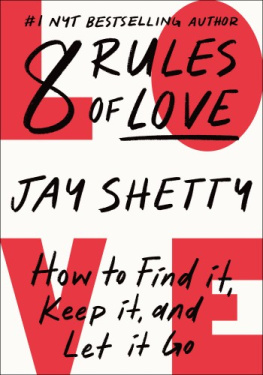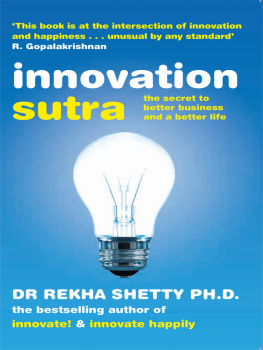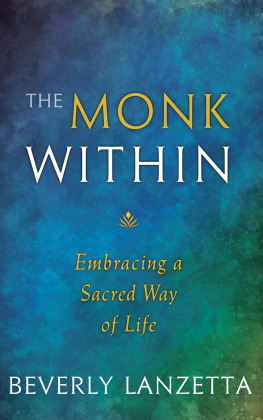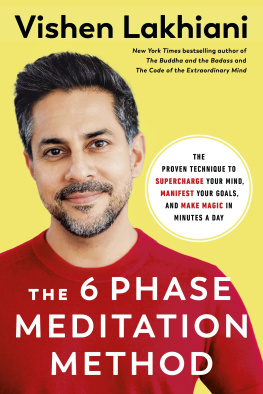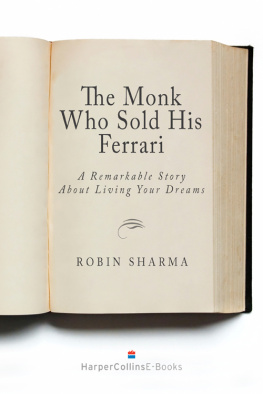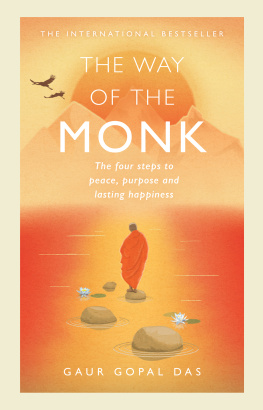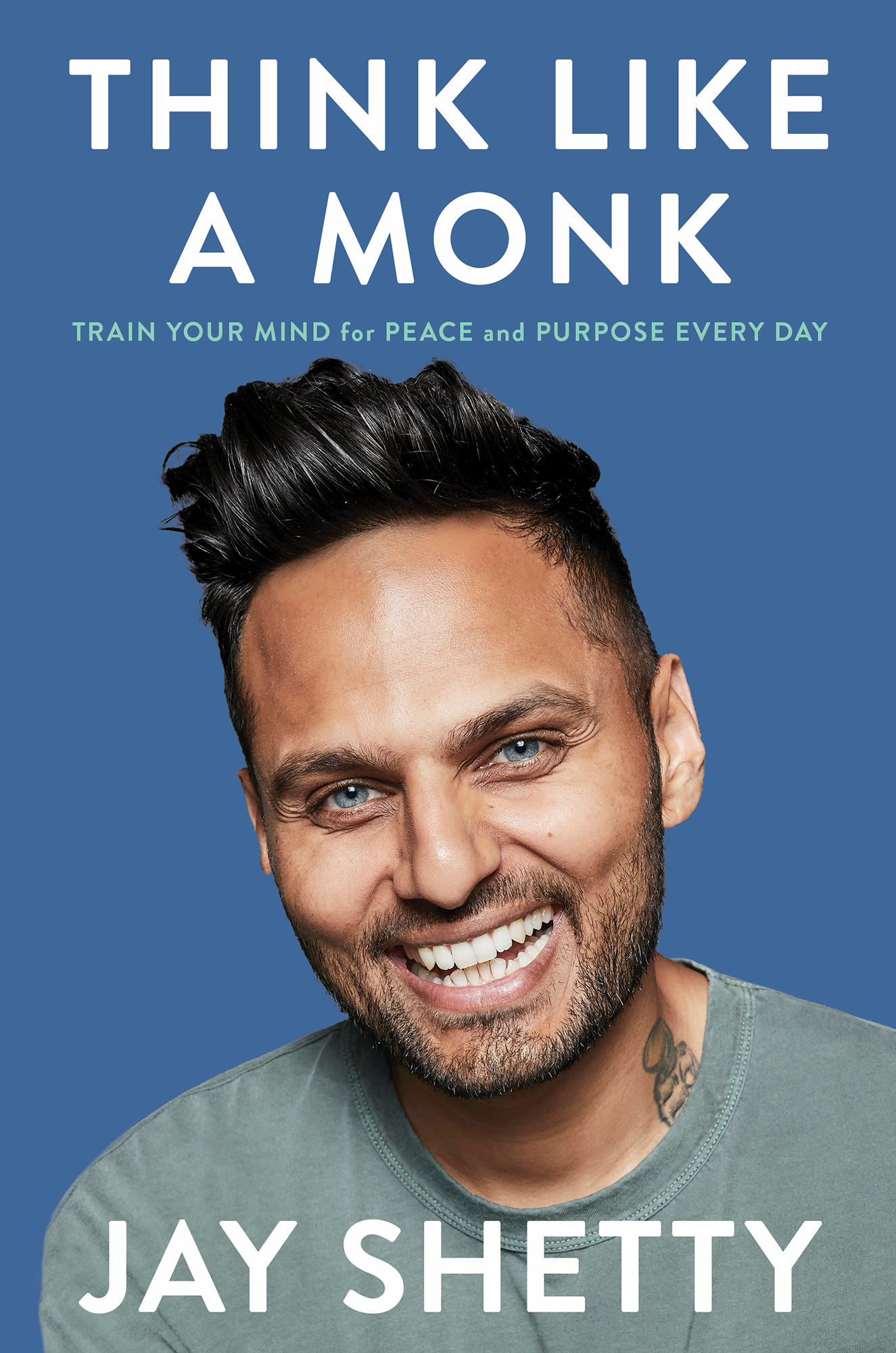Contents
Guide

Simon & Schuster, Inc.
1230 Avenue of the Americas
New York, NY 10020
Copyright 2020 by Jay R. Shetty
www.SimonandSchuster.com
All rights reserved, including the right to reproduce this book or portions thereof in any form whatsoever. For information, address Simon & Schuster Subsidiary Rights Department, 1230 Avenue of the Americas, New York, NY 10020.
First Simon & Schuster hardcover edition April 2020
SIMON & SCHUSTER and colophon are registered trademarks of Simon & Schuster, Inc.
For information about special discounts for bulk purchases, please contact Simon & Schuster Special Sales at 1-866-506-1949 or .
To contact Jay Shetty for speaking arrangements, please email .
Interior design by Ruth Lee-Mui
Jacket design by Jackie Seow
Jacket photograph by Steve Erle
Library of Congress Cataloging-in-Publication Data
Names: Shetty, Jay, author. Title: Think like a monk : train your mind for peace and purpose every day / Jay Shetty. Description: New York : Simon & Schuster, [2020] | Includes index. | Summary: Jay Shetty, social media superstar and host of the #1 podcast On Purpose, distills the timeless wisdom he learned as a monk into practical steps anyone can take every day to live a less anxious, more meaningful lifeProvided by publisher. Identifiers: LCCN 2020000011 (print) | LCCN 2020000012 (ebook) | ISBN 9781982134488 (hardcover) |ISBN 9781982149819 (paperback) | ISBN 9781982134501 (ebook) Subjects: LCSH: Self-realization. | Meaning (Psychology) | Conduct of life. | Hindu monastic and religious life. Classification: LCC BF637.S4 S526 2020 (print) | LCC BF637.S4 (ebook) | DDC 158.1dc23 LC record available at https://lccn.loc.gov/2020000011 LC ebook record available at https://lccn.loc.gov/2020000012
ISBN 978-1-9821-3448-8
ISBN 978-1-9821-3450-1 (ebook)
For my wife, who is more monk than I will ever be
Introduction
If you want a new idea, read an old book.
attributed to Ivan Pavlov (among others)
When I was eighteen years old, in my first year of college, at Cass Business School in London, one of my friends asked me to go with him to hear a monk give a talk.
I resisted. Why would I want to go hear some monk?
I often went to see CEOs, celebrities, and other successful people lecture on campus, but I had zero interest in a monk. I preferred to hear speakers whod actually accomplished things in life.
My friend persisted, and finally I said, As long as we go to a bar afterward, Im in. Falling in love is an expression used almost exclusively to describe romantic relationships. But that night, as I listened to the monk talk about his experience, I fell in love. The figure on stage was a thirty-something Indian man. His head was shaved and he wore a saffron robe. He was intelligent, eloquent, and charismatic. He spoke about the principle of selfless sacrifice. When he said that we should plant trees under whose shade we did not plan to sit, I felt an unfamiliar thrill run through my body.
I was especially impressed when I found out that hed been a student at IIT Bombay, which is the MIT of India and, like MIT, nearly impossible to get into. Hed traded that opportunity to become a monk, walking away from everything that my friends and I were chasing. Either he was crazy or he was onto something.
My whole life Id been fascinated by people whod gone from nothing to somethingrags-to-riches stories. Now, for the first time, I was in the presence of someone whod deliberately done the opposite. Hed given up the life the world had told me we should all want. But instead of being an embittered failure, he appeared joyous, confident, and at peace. In fact, he seemed happier than anyone Id ever met. At the age of eighteen, I had encountered a lot of people who were rich. Id listened to a lot of people who were famous, strong, good-looking, or all three. But I dont think Id met anyone who was truly happy.
Afterward, I pushed my way through the crowds to tell him how amazing he was, and how much hed inspired me. How can I spend more time with you? I heard myself asking. I felt the urge to be around people who had the values I wanted, not the things I wanted.
The monk told me that he was traveling and speaking in the UK all that week, and I was welcome to come to the rest of his events. And so I did.
My first impression of the monk, whose name was Gauranga Das, was that he was doing something right, and later I would discover that science backs that up. In 2002, a Tibetan monk named Yongey Mingyur Rinpoche traveled from an area just outside Kathmandu, Nepal, to the University of WisconsinMadison so that researchers could watch his brain activity while he meditated. The scientists covered the monks head with a shower caplike device (an EEG) that had more than 250 tiny wires sticking out of it, each with a sensor that a lab tech attached to his scalp. At the time of the study, the monk had accumulated sixty-two thousand hours of lifetime meditation practice.
As a team of scientists, some of them seasoned meditators themselves, watched from a control room, the monk began the meditation protocol the researchers had designedalternating between one minute of meditating on compassion and a thirty-second rest period. He quickly cycled through this pattern four times in a row, cued by a translator. The researchers watched in awe; at almost the exact moment the monk began his meditation, the EEG registered a sudden and massive spike in activity. The scientists assumed that with such a large, quick bump, the monk must have changed positions or otherwise moved, yet to the observing eye, he remained perfectly still.
What was remarkable was not just the consistency of the monks brain activityturning off and on repeatedly from activity to rest periodbut also the fact that he needed no warm-up period. If youre a meditator, or have at least tried to calm your brain, you know that typically it takes some time to quiet the parade of distracting thoughts that marches through your mind. Rinpoche seemed to need no such transition period. Indeed, he seemed to be able to come in and out of a powerful meditative state as easily as flipping a switch. More than ten years after these initial studies, scans of the forty-one-year-old monks brain showed fewer signs of aging than his peers. The researchers said he had the brain of someone ten years younger.
Researchers who scanned Buddhist monk Matthieu Ricards brain subsequently labeled him the Worlds Happiest Man after they found the highest level of gamma wavesthose associated with attention, memory, learning, and happinessever recorded by science. One monk whos off the charts may seem like an anomaly, but Ricard isnt alone. Twenty-one other monks who had their brains scanned during a variety of meditation practices also showed gamma wave levels that spiked higher and lasted longer (even during sleep) than non-meditators.
Why should we think like monks? If you wanted to know how to dominate the basketball court, you might turn to Michael Jordan; if you wanted to innovate, you might investigate Elon Musk; you might study Beyonc to learn how to perform. If you want to train your mind to find peace, calm, and purpose? Monks are the experts. Brother David Steindl-Rast, a Benedictine monk who cofounded gratefulness.org, writes, A layperson who is consciously aiming to be continuously alive in the Now is a monk.


